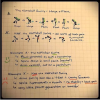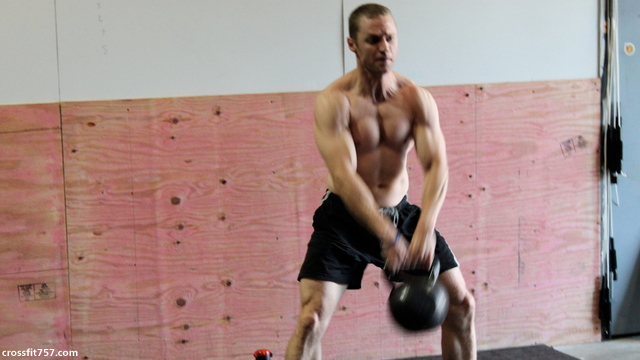I think if you hammer home the hinge and plank positions, and make the student focus on using their chambering and hip snap to hit proper height, they'll eventually pick up how to sync up the timing themselves.
I agree!
I think if you hammer home the hinge and plank positions, and make the student focus on using their chambering and hip snap to hit proper height, they'll eventually pick up how to sync up the timing themselves.
First off, I don't think your hip pushes are technically wrong, they just aren't as powerful. Hip pushes are probably OK in the early learning of swing technique when you're trying to develop the hinge and plank positions.
Your regular swings are overall more powerful. If you pause the swings the instant you hit full plank, the bell is at a higher point of the arc than when you do the hip push. All the work is done at that point. Once you hit plank, you are just waiting for the float.
You are also chambering your backswing deeper on your regular swings. You can see your fingers appear on the back swing, not on your hip pushes. This extra springing helps launch the bell out of the hinge.
Excuse me but I don't understand the point.
If you don't push whit your hips, how do you transfer movement to the bell assumed the arms are like ropes, so they only support passively the weight?

Excuse me but I don't understand the point.
If you don't push whit your hips, how do you transfer movement to the bell assumed the arms are like ropes, so they only support passively the weight?
KimeI do remember about this from S&S ...
And, I thought this passage from S&S would also be of value in this discussion...
View attachment 10157
I think that there can be value in playing with our ability to control a sharp and shortened acceleration with our lighter bells. i know i have a 35 lbs and 55lbs and the 35 is starting to fly very high in the swing . so i've been noting this idea this past week in my practice to play with the idea of not doing too much with the lighter bell.
the mechanics of the shoulders moving up and back is what launches the kettlebell forward? It's the force of hip and knee extension into the ground, moving the shoulders up and back.
I've just been starting to "get" this and it's come from going heavy. Was swinging 44% bodyweight, my heaviest kb so recently built a core blaster. Now swinging 67% bw (after a couple weeks at 58%) and discovering all sorts of little glitches and power leaks that were just not noticeable at the lower weight.There is tension through the whole chain (arms to hips) that locks up. That connection transfers the energy.
Using the drawings in the first line, can you see how the mechanics of the shoulders moving up and back is what launches the kettlebell forward? It's the force of hip and knee extension into the ground, moving the shoulders up and back. It goes up, then gravity and the connection to the arms pulls it back into the hinge as you move into that position again, "chambering" it for another upswing.
It is possible to do kettlebell swings with absolutely no contact between hips and forearms. I don't recommend it for general practice, because it's not something to avoid entirely -- but is a neat exercise to try with a light kettlebell so you can get the feel of the power transfer with no direct pushing action.
(Edit/Add: You can do this same exercise with a can of soup or literally any weight in your hand. It doesn't matter what it is. Practice the hip snap and see how high you can make it go by going from hinge to plank.).
There is tension through the whole chain (arms to hips) that locks up. That connection transfers the energy.
swinging a lighter weight to a less-than-maximum height might require starting to decelerate the bell sooner.

I've just been starting to "get" this and it's come from going heavy. Was swinging 44% bodyweight, my heaviest kb so recently built a core blaster. Now swinging 67% bw (after a couple weeks at 58%) and discovering all sorts of little glitches and power leaks that were just not noticeable at the lower weight.
In the t-nation article linked to above there is a video of a woman doing what is called perfect kettlebell swings. Would you agree that we should bend/be drawn that much forward/downwards? Just curious.Hyperextension
Leaning back is a common error. It places a great deal of stress on the lower back.
As you noted, individual do it so they can swing the Kettlebell higher.
The same hyperextension issue occur with other movement like the Deadlift and Back Raises.
The Kettlebell Swing Height
The height of the Kettlebell Swing is determined by the load.
The lighter the load, the higher the height of the Kettlebell Swing.
The heavier the load, the lower the height of the Kettlebell Swing.
Posterior Chain Kettlebell Swings
As with any exercise, optimal training effect is elicited when the movement is performed within the right training percentage of a 1 Repetition Max with the correct technique.
Kettlebells Swings For Power
The Kettlebell Swing is a Power Movement.
This article goes into the loads needed for developing Power with the Kettlebell Swing
Are Heavy Kettlebell Swings Better Than Deadlifts?

Are Heavy Kettlebell Swings Better Than Deadlifts?
Heavy kettlebell swings could be the best damn posterior chain exercise you're not doing, possibly even better than deadlifts! Here's why.www.t-nation.com
Contreras' research determined that Heavy Kettlebell Swings are necessary for developing Power with the Kettlebell Swing.
That means performing Kettlebell Swing with with up you body weight. If you weight 200 lbs, some individual may be able to work up to Kettlebell Swing using a 200 lb Kettlebell.
One individual case study, that was posted on this site, indicted that performing a Kettlebell Swing with around one-third of you body weight was effective.
Base on Contreras's research and my personal experience, it appears that performing the Kettlebell Swing with one-third of your body weight is good starting point, with heavier loads increasing greater Power Output, dependent on your strength level.
The downside is that you'll have to take out a second mortgage on your house to afford a 200 lb Kettlebell.
However, there is a solution...
The Hungarian Core Blaster
Contreras' article provides information on how to make it.
The cost is around $20.00 worth of pipe from Lows and some standard 1 inch weight plates. It takes less than 5 minute to assemble it.
The nice thing about the Hungarian Core Blaster is the it's adjustable. You can increase of decrease the load, as you l
I've Hungarian Core Blaster for about 5 years. At a body weight of 194 lbs, I've worked to Swings with 170 lbs.
Zack Henderson's Stomach Height
Obviously, there is an inverse relationship in regard to the height of a Kettlebell Swing to the Kettlebell weight.
The apex of a good heavy Kettlebell Swing is going to be around the stomach area, as Henderson stated.
If you are able to Swing the Kettlebell any higher, that means the load is too light.
The Banded Alternative Kettlebell Swing

Plyometrics without Jumping
Plyometrics offer many benefits to athletes. It builds explosive power and neurological responsiveness that allows for change of direction…medium.com
Dr Craig Marker's Banded Kettlebell Swing (video demonstration) shows you to how to increase the top end loading of the Kettlebell Swing with your current Kettlebells.
In the t-nation article linked to above there is a video of a woman doing what is called perfect kettlebell swings. Would you agree that we should bend/be drawn that much forward/downwards? Just curious.
T-Nation ArticleIn the t-nation article linked to above there is a video of a woman doing what is called perfect kettlebell swings.
